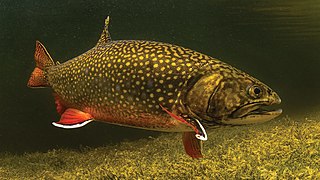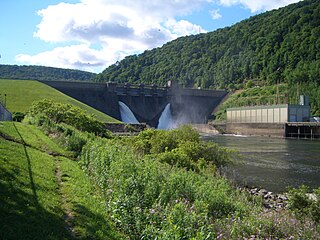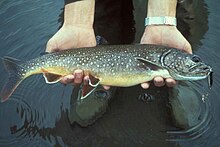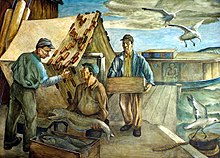
Trout is a generic common name for numerous species of carnivorous freshwater ray-finned fishes belonging to the genera Oncorhynchus, Salmo and Salvelinus, all of which are members of the subfamily Salmoninae in the family Salmonidae. The word trout is also used for some similar-shaped but non-salmonid fish, such as the spotted seatrout/speckled trout.

The brook trout is a species of freshwater fish in the char genus Salvelinus of the salmon family Salmonidae native to Eastern North America in the United States and Canada. Two ecological forms of brook trout have been recognized by the US Forest Service. One ecological form is short-lived potamodromous populations in Lake Superior known as coaster trout or coasters. The second ecological form is the long-living predaceous anadromous populations which are found in northern lakes and coastal rivers from Long Island to Hudson Bay, which are referred to as salters. In parts of its range, it is also known as the eastern brook trout, speckled trout, brook charr, squaretail, brookie, or mud trout, among others. Adult coaster brook trout are capable of reaching sizes over 2 feet in length and weigh up to 6.8 kg, whereas adult salters average between 6 and 15 inches in length and weigh between 0.5 and 2.3 kg. The brook trout is characterized by its distinctive olive-green body with yellow and blue-rimmed red spots, white and black edged orange fins, and dorsal vermiculation. The diet of the brook trout is restrictive to the season and location of the fish, but will typically consist of terrestrial and aquatic insects, fry, crustaceans, zooplankton, and worms.

The cutthroat trout(Oncorhynchus clarkii) is a fish species of the family Salmonidae native to cold-water tributaries of the Pacific Ocean, Rocky Mountains, and Great Basin in North America. As a member of the genus Oncorhynchus, it is one of the Pacific trout, a group that includes the widely distributed rainbow trout. Cutthroat trout are popular gamefish, especially among anglers who enjoy fly fishing. The common name "cutthroat" refers to the distinctive red coloration on the underside of the lower jaw. The specific name clarkii was given to honor explorer William Clark, coleader of the Lewis and Clark Expedition.

The Arctic char or Arctic charr is a cold-water fish in the family Salmonidae, native to alpine lakes, as well as Arctic and subarctic coastal waters in the Holarctic.

The silver trout is an extinct char species or subspecies that inhabited a few waters in New Hampshire in the United States prior to 1939, when a biological survey conducted on the Connecticut watershed by the New Hampshire Fish and Game Department found none.

Salvelinus is a genus of salmonid fish often called char or charr; some species are called "trout". Salvelinus is a member of the subfamily Salmoninae within the family Salmonidae. The genus has a northern circumpolar distribution, and most of its members are typically cold-water fish that primarily inhabit fresh waters. Many species also migrate to the sea.
The aurora trout, Salvelinus fontinalis timagamiensis, is a variant or subspecies of the brook trout native to two lakes in the Temagami District of Ontario, Canada. The existence of the fish was brought to the attention of the angling world by four American anglers who were taken by Archie King of Latchford, Ontario, into Ontario's Lady Evelyn River system in 1923. Recognizing the fish as different or unique, the anglers took a specimen back to the Carnegie Museum in Pittsburgh, in the United States, where Dr. Arthur W. Henn was asked to identify the fish. He wrote about the fish in 1925 wherein he and Rinckenbach identified it as a distinct species, Salvelinus timagamiensis, but since a seminal re-examination of the material by Sale in 1967, taxonomists now agree the fish is, in a fact, at most a subspecies of the brook trout, named Salvelinus fontinalis timagamiensis. Genetic data has not yet supported its taxonomic distinction.

The splake or slake is a hybrid of two fish species resulting from the crossing of a male brook trout and a female lake trout. The name itself is a portmanteau of speckled trout and lake trout, and may have been used to describe such hybrids as early as the 1880s. Hybrids of the male lake trout with the female brook trout have also been produced, but are not as successful.

The tiger trout is a sterile, intergeneric hybrid of the brown trout and the brook trout. Pronounced vermiculations in the fish's patterning gave rise to its name, evoking the stripes of a tiger. Tiger trout are a rare anomaly in the wild, as the parent species are relatively unrelated, being members of different genera and possessing mismatched numbers of chromosomes. However, specialized hatchery rearing techniques are able to produce tiger trout reliably enough to meet the demands of stocking programs.

The shortjaw cisco is a North-American freshwater whitefish in the salmon family. Adult fish range to about 30 cm (12 in) in length and are silver, tinged with green above and paler below. One of the members of the broader Coregonus artedi complex of ciscoes, it is distributed widely in the deeper lakes of Canada, but populations in the Great Lakes have been declining and it is no longer present in Lakes Michigan, Huron, and Erie. It feeds mainly on crustaceans and insect larvae and spawns in the autumn on the lake bed. It is part of the important cisco (chub) fishery in the Great Lakes. The International Union for Conservation of Nature has rated its conservation status as "vulnerable". Shortjaw cisco have however evolved from the cisco Coregonus artedi independently in different lakes and different parts of the range, and conservation assessments therefore should be made on a lake-wise rather than range-wide basis.

Coregonus artedi, commonly known as the cisco, is a North American species of freshwater whitefish in the family Salmonidae. The number of species and definition of species limits in North American ciscoes is a matter of debate. Accordingly, Coregonus artedi may refer either in a narrow sense to one of the several types of cisco found e.g. in the Great Lakes, or in a broad sense to the complex of all ciscoes in continental North American lakes, Coregonus artedi sensu lato.

The Allegheny National Fish Hatchery was established by Congress in 1959 to produce rainbow, brook, and brown trout for northwestern Pennsylvania streams. Construction began in the late 1960s. Fish production began on site in 1974.
Salmonid herpesvirus 3 (SalHV-3) is a species of virus in the genus Salmonivirus, family Alloherpesviridae, and order Herpesvirales.
Fishing in Colorado has brought in a large amount of revenue for the state. In 2019 Colorado Parks and Wildlife estimated outdoor recreation contributed roughly 62 billion dollars to the state economy. Fishing was reported to be the 5th most popular outdoor activity and 110, 511 fishing and hunting combination licenses were sold. Ice fishing makes up part of this total fishing revenue and is a common annual sport for Colorado residents and out-of-state visitors. There is no legal definition of ice fishing season. Rather, people begin to ice fish once the lakes freeze over with thick enough ice. Colorado Parks and Wildlife also recommend that people always ice-fish with another person. Typically, this starts in December and ends in April for Colorado. Lakes size, depth, elevation, and seasonal weather can cause variance to the season. Once the lakes freeze over with thick enough ice, anglers go out onto the ice, drill holes through the ice, and fish for a variety of species.















